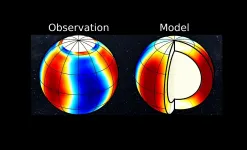Long-period oscillations of the Sun discovered
Ten years of data from NASA's Solar Dynamics Observatory combined with numerical models reveal the deep low musical notes of the Sun.
2021-07-20
(Press-News.org) These motions were measured by analyzing 10 years of observations from NASA's Solar Dynamics Observatory (SDO). Using computer models, the scientists have shown that the newly discovered oscillations are resonant modes and owe their existence to the Sun's differential rotation. The oscillations will help establish novel ways to probe the Sun's interior and obtain information about our star's inner structure and dynamics. The scientists describe their findings in today's issue of the journal Astronomy & Astrophysics.
In the 1960s the Sun'ss high musical notes were discovered: The Sun rings like a bell. Millions of modes of acoustic oscillations with short periods, near 5 minutes, are excited by convective turbulence near the solar surface and are trapped in the solar interior. These 5-minute oscillations have been observed continuously by ground-based telescopes and space observatories since the mid 1990s and have been used very successfully by helioseismologists to learn about the internal structure and dynamics of our star - just like seismologists learn about the interior of the Earth by studying earthquakes. One of the triumphs of helioseismology is to have mapped the Sun's rotation as a function of depth and latitude (the solar differential rotation).
In addition to the 5-minute oscillations, much longer-period oscillations were predicted to exist in stars more than 40 years ago, but had not been identified on the Sun until now. "The long-period oscillations depend on the Sun's rotation; they are not acoustic in nature", says Laurent Gizon, lead author of the new study and director at the MPS. "Detecting the long-period oscillations of the Sun requires measurements of the horizontal motions at the Sun's surface over many years. The continuous observations from the Helioseismic and Magnetic Imager (HMI) onboard SDO are perfect for this purpose."
The team observed many tens of modes of oscillation, each with its own oscillation period and spatial dependence. Some modes of oscillation have maximum velocity at the poles, some at mid-latitudes, and some near the equator. The modes with maximum velocity near the equator are Rossby modes, which the team had already identified in 2018. "The long-period oscillations manifest themselves as very slow swirling motions at the surface of the Sun with speeds of about 5 kilometers per hour - about how fast a person walks", says Zhi-Chao Liang from MPS. Kiran Jain from NSO, together with B. Lekshmi and Bastian Proxauf from MPS, confirmed the results with data from the Global Oscillation Network Group (GONG), a network of six solar observatories in the USA, Australia, India, Spain, and Chile.
To identify the nature of these oscillations, the team compared the observational data to computer models. "The models allow us to look inside the Sun's interior and determine the full three-dimensional structure of the oscillations", explains MPS graduate student Yuto Bekki. To obtain the model oscillations, the team began with a model of the Sun's structure and differential rotation inferred from helioseismology. In addition, the strength of the convective driving in the upper layers, and the amplitude of turbulent motions are accounted for in the model. The free oscillations of the model are found by considering small-amplitude perturbations to the solar model. The corresponding velocities at the surface are a good match to the observed oscillations and enabled the team to identify the modes.
"All of these new oscillations we observe on the Sun are strongly affected by the Sun's differential rotation", says MPS scientist Damien Fournier. The dependence of the solar rotation with latitude determines where the modes have maximum amplitudes. "The oscillations are also sensitive to properties of the Sun's interior: in particular to the strength of the turbulent motions and the related viscosity of the solar medium, as well as to the strength of the convective driving," says Robert Cameron from MPS. This sensitivity is strong at the base of the convection zone, about two hundred thousand kilometers beneath the solar surface. "Just like we are using acoustic oscillations to learn about the sound speed in the solar interior with helioseismology, we can use the long-period oscillations to learn about the turbulent processes", he adds.
"The discovery of a new type of solar oscillations is very exciting because it allows us to infer properties, such as the strength of the convective driving, which ultimately control the solar dynamo", says Laurent Gizon. The diagnostic potential of the long-period modes will be fully realized in the coming years using a new exascale computer model being developed as part of the project WHOLESUN, supported by a European Research Council 2018 Synergy Grant.
INFORMATION:
Additional material may be downloaded from http://www2.mps.mpg.de/projects/seismo/SolarInertialModes/.
The A&A Letter describing the results is available at https://www.aanda.org/10.1051/0004-6361/202141462.
[Attachments] See images for this press release:

ELSE PRESS RELEASES FROM THIS DATE:
2021-07-20
New findings from zoologists working with birds in Southeast Asia are shining fresh light on the connections between animal behaviour, geology, and evolution - underlining that species can diversify surprisingly quickly under certain conditions.
The zoologists, from Trinity College Dublin's School of Natural Sciences, sequenced DNA and took measurements and song recordings from Sulawesi Babblers (Pellorneum celebense), shy birds that live in the undergrowth on Indonesian islands.
Although these islands were connected by land bridges just tens of thousands of years ago, and although the babblers look ...
2021-07-20
One of the leading thinkers in nano-science has called on the energy materials community to help finally put an end to the world's reliance on fossil fuels.
In a hard-hitting editorial published by Energy and Environmental Materials, Professor Ravi Silva, Director of the Advanced Technology Institute (ATI) at the University of Surrey, argues that there are no coherent excuses left to justify the use of fossil fuels. In his paper, Professor Silva challenges the scientific community to lead the world away from a reality where fossil fuels still account for 80 per cent of the energy mix.
While the cost of clean energy generation has plummeted over recent years, ...
2021-07-20
Hydropower has massive potential as a source of clean electricity, and the Indus basin can be a key player in fulfilling long-term energy storage demands across Africa, Asia, Europe, and the Middle East. IIASA researchers explored the role the Indus basin could play to support global sustainable development.
According to the International Energy Agency (IEA), the growth of hydropower plants worldwide is set to slow down this decade. This puts at risk the ambitions of countries across the globe aiming to reach net-zero emissions while ensuring reliable and affordable energy supplies for their citizens. Even so, there are thousands of dams planned to be built this next decade. New hydropower dams installed worldwide are forecasted to increase global hydroelectricity ...
2021-07-20
Decreasing bacterial acidity could help reduce antimicrobial resistance by eliminating bacteria that can survive being treated with antibiotics.
Scientists at the University of Exeter have developed a novel method, which allows users to measure the pH of individual bacteria before, during and after treatment with antibiotics.
The research, published in the journal mBio, lays the foundation for understanding the special properties of bacteria that survive being treated with antibiotics, so that new ways of targeting them can be developed.
The Exeter University research team found that even before antibiotic treatment, common infection causing Escherichia coli cells that can survive treatment have a more acidic intracellular pH compared to clonal cells that are eliminated ...
2021-07-20
Interstellar clouds are the birthplaces of new stars, but they also play an important role in the origins of life in the Universe through regions of dust and gas in which chemical compounds form. The research group, molecular systems, led by ERC prize winner Roland Wester at the Institute for ion physics and applied physics at the University of Innsbruck, has set itself the task of better understanding the development of elementary molecules in space. "Put simply, our ion trap allows us to recreate the conditions in space in our laboratory," explains ...
2021-07-20
Amsterdam, July 20, 2021 - Well over six million people globally have been diagnosed with Parkinson's disease (PD), which has an enormous impact on the lives of patients, their families, and caregivers and is incurring mounting costs for society. This special supplement to the Journal of Parkinson's Disease (JPD), guest-edited by noted experts Anat Mirelman, PhD, E. Ray Dorsey, MD, MBA, Patrik Brundin, MD, PhD, and Bastiaan R. Bloem, MD, PhD, reviews how digital technology is being used to reshape research and clinical care in PD.
Digital health technology is an umbrella term that spans a diverse range of applications, including body-fixed wearable sensors, non-contactable domestic sensors, smartphone apps, and videoconferencing and other telemedicine systems that allow for direct remote ...
2021-07-20
MINNEAPOLIS/ST. PAUL (07/20/2021) -- National data analyzed by University of Minnesota Medical School researchers show that nearly 40 percent of all funds used to pay for medical school are expected to come from family or personal sources and scholarships. The prevalence of these sources, however, varies widely by race and socioeconomic status.
Arman Shahriar, Varun Sagi and Lorenzo Gonzalez, all fourth-year students at the University of Minnesota Medical School, are co-lead authors of the study, which was published today in JAMA Network Open.
"Financing a four-year medical education requires upwards of a quarter-million dollars, and this amount has been rising faster than inflation since the 1960s. Prior to this study, ...
2021-07-20
Despite the best efforts of industry to work towards sustainability, most plastics (or polymers) are still made using non-renewable fossil fuels. However, researchers have now found an economical method for producing biobased acrylate resins. The study, published in the journal Angewandte Chemie, shows how all the synthesis steps, from initial building blocks right up to polymerization, can be carried out in a single reactor (one pot), minimizing environmental impact.
Most varnishes, adhesives and paints are made from acrylate resins, which are polymers of acrylic acid esters and methacrylic acid esters. The raw materials that form these ...
2021-07-20
The sight of felled trees and logging activity can be jarring for nature lovers, but from those sites can sprout young forest growth that's especially attractive to a familiar inhabitant of wooded areas throughout the Northeast - bats.
New findings from researchers at the UConn College of Agriculture, Health, and Natural Resources, published in Forest Ecology and Management, finds that a number of bat species native to the Northeast are highly active in newly created forest spaces, foraging for food at higher rates than is typical of mature forests.
Little is known about ...
2021-07-20
Vaccine hesitancy continues to be a hurdle in the development of widespread immunity within the U.S. population as the COVID-19 pandemic enters its second year.
Researchers at the University of Cincinnati College of Medicine have developed a computerized decision analytic model to compare projected outcomes of three vaccine strategies: a patient opts for a messenger RNA vaccine, a patient decides to get an adenovirus vector vaccine or the patient simply forgoes a vaccine altogether.
Pfizer and Moderna produce mRNA vaccines while Johnson & Johnson manufacture an adenovirus vector vaccine. The decision analytic ...
LAST 30 PRESS RELEASES:
[Press-News.org] Long-period oscillations of the Sun discovered
Ten years of data from NASA's Solar Dynamics Observatory combined with numerical models reveal the deep low musical notes of the Sun.



